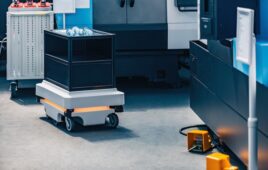ADC’s test systems for sporting equipment cut $4,000 in hardware costs per machine using integrated PC-based control and expandable measurement tech from Beckhoff.
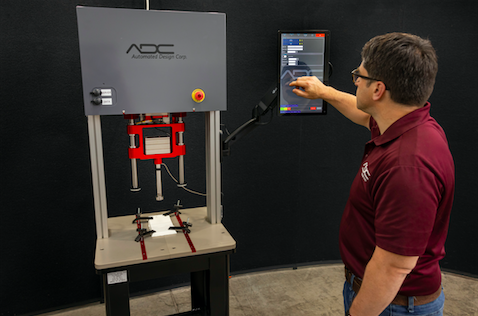
ADC’s redesigned ASTM Impact Tester combines high-end measurement with intuitive operation. (© Beckhoff, 2023)
Thomas Bitsky, Jr. often sees machine design like coaching. That is, it’s like coaching a team of athletes with disparate skills and from backgrounds that don’t often mesh. As Vice President and Lead Developer at Automated Design Corporation (ADC), Bitsky designs and programs systems that employ industrial automation and test and measurement technology. Take ADC’s redesigned Impact Tester as an example.
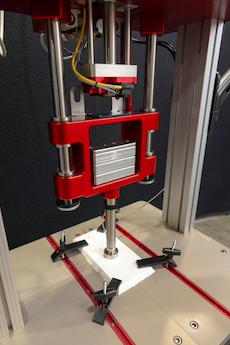
EtherCAT ensures synchronization of load versus position for test integrity. (© Beckhoff, 2023)
“The impact testing system, like most others, is more industrial than typical desktop lab-type boxes, but it offers more data acquisition (DAQ) than legacy automation and controls technology,” Bitsky said.
This type of challenge is home turf for ADC. Founded in 1986, the company originally focused on traditional manufacturing equipment for automotive and other industries. In the early ‘90s, ADC acquired a machine shop that built systems for a major sporting goods brand and added testing equipment to its specialties. Now, the company supplies R&D systems to every major sporting goods manufacturer across multiple sports.
ADC’s redesigned Impact Tester system adheres to the ASTM F1976 and F1614 standards for impact attenuation of cushioning in athletic shoes. For accurate test results, the motion control and DAQ technologies must synchronize perfectly, which creates challenges when using separate solutions. So, ADC harnessed the flexible, fully integrated, and real-time solution from Beckhoff for both PC-based automation and expandable measurement. Here, Beckhoff’s ELM high-end measurement I/O terminals provided significant advantages.
ADC needed to meet several technological requirements when building the Impact Tester. Precision motion, real-time fieldbus communication, and fast cycle times were necessary. The proposed system would be more advanced regarding software, mechanical, and electrical engineering, and a more intuitive HMI was mandatory.
Another hurdle had nothing to do with technological capabilities. Instead, it involved gaining acceptance of a new solution that could go beyond the narrow list of test and measurement component vendors offering standalone black boxes.
This industry has remained siloed for far too long, according to Bitsky. In the past, of course, the high sample rates needed to ensure quality could only be found in components from select vendors. Still, industrial automation has converged with test and measurement technology. Test procedures often require greater control and kinematics capabilities than what a typical chassis-style DAQ controller running LabVIEW software can offer. When depending on these DAQ controls, automated handling for tests and moving objects into and out of the cell, require a separate PLC, Bitsky explained: “Both scenarios add cost, communication delays, and cabling nightmares.”
Conversely, engineers are now more comfortable adding test and measurement equipment to manufacturing machinery. However, the production environment often proves too harsh for traditional components. “When you start up a servomotor or VFD, the electrical transients go into the encoder, and that can make the counters on desktop DAQ boxes go haywire,” Bitsky said. “With the integrated DAQ technologies from Beckhoff, we get the performance we need without these issues.”
EtherCAT goes for the goal in expandable measurement
Since 2006, Bitsky has worked closely with the team based at Beckhoff’s Chicago-area sales and training office. Beckhoff Regional Sales Engineer Mike Rauch and Applications Engineer Dave Zimbrich have provided guidance and hands-on assistance for many ADC projects for the test and measurement systems and general industrial automation.
“ADC recognized the power of our EtherCAT industrial Ethernet system for fast communication in data-intensive applications, and the ELM cards have increased their capabilities for integrated data acquisition,” Rauch said.
EtherCAT offers many benefits regarding topology, functional safety, and network size, but the main advantages for ADC are speed and bandwidth. Standard 100 Mbit/s EtherCAT with oversampling capabilities supports the various test systems. Oversampling functionality means reading data multiple times per cycle for enhanced time resolution of a signal.
On the Impact Tester, ADC was able to use commercial off-the-shelf (COTS) measurement terminals to eliminate expensive, specialized hardware. The DIN rail-mounted ELM3502 EtherCAT Terminals are fully integrated into the standard Beckhoff I/O system and offer dual-channel measurement in a ruggedized metal housing. With sampling rates up to 20 ksps, the terminal covers most advanced measurement requirements for ADC. Bitsky learned about the ELM series, which offers terminals supporting up to 50 ksps when visiting the Hannover Messe trade show in 2019.
“We had been using other Beckhoff measurement terminals — particularly the EL3356, which works well for industrial applications. But our test and measurement customers needed sampling in the kilohertz range that only legacy DAQ vendors offered previously,” he said.
ADC started using the ELM3502 modules on their compression systems and saw significant improvements. So, it made sense to design the Beckhoff measurement terminals for the Impact Tester; Bitsky explained: “The ELM terminals delivered the sampling rates we needed, along with perfect synchronization to the controller via EtherCAT. Now, the machines can load test specimens very quickly. In one scan, I get all motion and load data, and our Gage R&Rs look as good if not better than what we got with the traditional chassis-style controller.”
Control and motion solutions work smarter not harder
On the controls side, ADC relies on a Beckhoff CX5130 Embedded PC running TwinCAT 3 automation software. One fanless machine controller delivers ample computing power for data acquisition and motion control in the test systems. “The scalability of our Embedded PC series allows ADC to increase performance levels when needed without reprogramming or reengineering their systems,” Rauch said. “That flexibility makes the complex world of test and measurement a little simpler.”
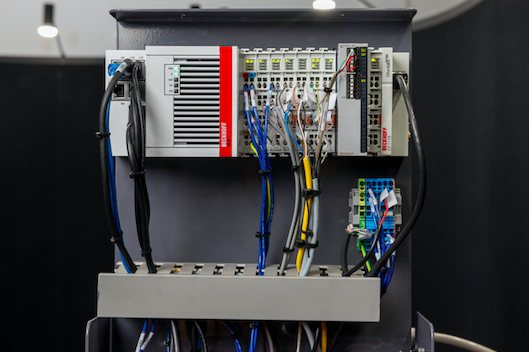
Beckhoff offered powerful control and DAQ technologies in space-saving form factors, including the DIN rail-mounted CX5130 Embedded PC (left) and ELM3502 measurement terminal (metal module on right). (© Beckhoff, 2023)
TwinCAT 3 delivered an end-to-end automation runtime and engineering environment. The software offers a more standardized programming environment, according to Bitsky. However, it also easily integrates LabVIEW and other third-party software. With TwinCAT, engineers can program in the languages they are most familiar with or that best fit the project, including the available IEC 61131-3 languages and their object-oriented extensions, function blocks and computer science standards found in Microsoft Visual Studio.
The Beckhoff drive technology portfolio complements the needs of these systems. The compact EL7211 servo terminals and EL7041 stepper terminals deliver high-performance drive technology in an I/O slice form factor. ADC also leverages the EL5101 single-channel encoder interface.
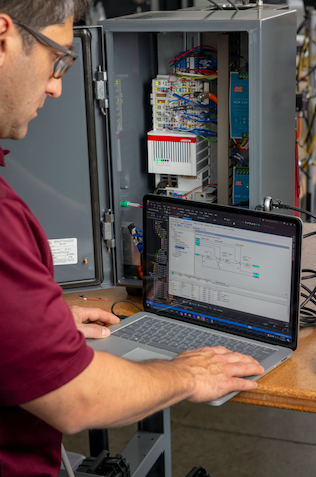
TwinCAT 3 automation software streamlined engineering using standard PLC programming and computer science languages. (© Beckhoff, 2023)
“We can also use third-party motors and drives, and if they’re EtherCAT-based, the integration is incredibly simple. We use the motion control libraries in TwinCAT for all these devices,” Bitsky said. “Most of our applications require simple point-to-point motion. We apply a specified load to the material, which requires synchronization between the load cell input and motion controller, and then read the position. If you go past that load, the test will fail to execute.
“The legacy, chassis-style controllers just don’t have the power to support this functionality,” he added. “But the distributed clocks in EtherCAT ensure synchronization of load versus position.”
One winning team handles DAQ and automation
ADC already saw benefits from the Beckhoff portfolio, but because of the company’s success with the ELM series, it has started implementing those terminals across its machines. The system met all requirements for enhanced measurement and control capabilities, and using COTS automation components also led to cost savings of about $4,000 per machine. The Beckhoff solution also reduced wiring, assembly, and programming time.
Beckhoff Automation
www.beckhoff.com
Filed Under: Industrial automation



